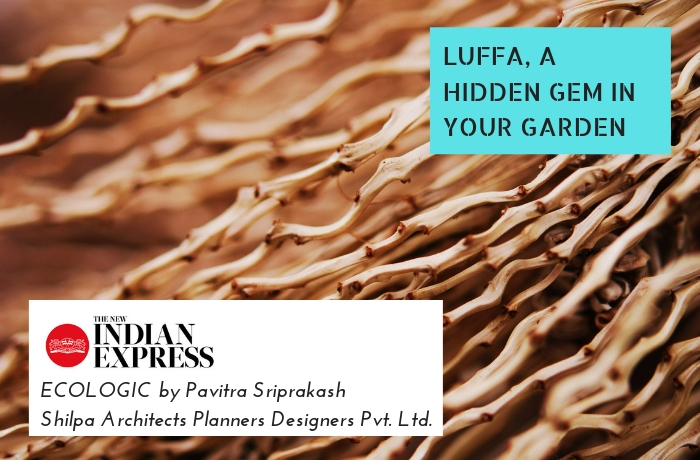11-Dec-2018: Pavitra Sriprakash, Director and Chief Designer at Shilpa Architects Planners Designers writes a weekly column on Sustainability for The New Indian Express titled “ECOLOGIC”. This week she writes about ideas of replacing plastic with organic products from our garden.
Full Article below: (Also available at The New Indian Express Website)
What started off as a way to replace plastic in the showers — by getting rid of the ‘bath loofah’ with a natural product opened my eyes to the existence of yet another bio-wonder with immense possibilities. The thought of growing my own ‘luffa’ came to me after my father grew some in his backyard and then sent over a batch of this fibery material to be replaced in our showers. With that grew the intrigue in this material, and soon we were proponents of luffa, proudly handing it to family and friends encouraging them to make a switch in their baths and kitchens.
So what is luffa? Luffa, a.k.a. loofa or loofah, refers to two species of gourd: Luffa aegyptiaca (vegetable gourd) and L acutangula (gourd loofa). Both the species are used interchangeably, and both are vines with yellow flowers that thrive in our climate. Luffas belong to the gourd family, along with squashes, watermelons, cucumbers and hard-shelled gourds. In most cases, luffa can be harvested for their fruit or allowed to mature completely in case of them being harvested for the fiber.
To harvest luffa for the fiber, the fruits are allowed to mature on the vine until they turn yellow or brownish. It is then peeled to reveal the matrix of tough fibrous tissues inside that act as wonderful natural sponges. Luffa-derived sponges are tough on dirt but non-abrasive and perfect for washing your face, body, dishes, floor, or car, and can be found in our traditional medicine stores quite easily. They are even embedded as slices in home made soaps to add the extra scrub in them.
It so happened that my recent garden project turned into a great discovery of a hidden gem. Luffa has been making its way into low cost sustainable building materials in many countries across the world. In Paraguay, the lack of wood as a building material and the need for low cost housing solutions to house some 300,000 families drove community activist Elsa Zaldívar to come up with an innovative green building material. Luffa wastage created by trim from the export bath sponge market were being sent to the landfill. This waste, combined with recycled plastic and other agrifibers (corn husks and palm leaves), formed a composite panel. These panels are an inexpensive, lightweight, flexible building material that helped communities reduce their agricultural waste while generating income and providing sustainable housing.
The humble luffa comes full circle —from a simple scrubber in the shower to a new age sustainable building material — there is more power in your home garden than you can imagine!
The writer is an architect, urban designer, dancer and chief designer at Shilpa Architects Planners Designers Pvt. Ltd..



